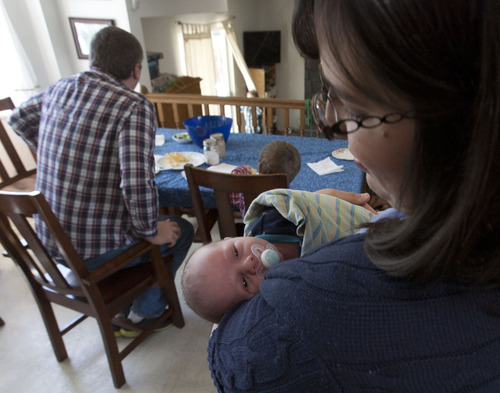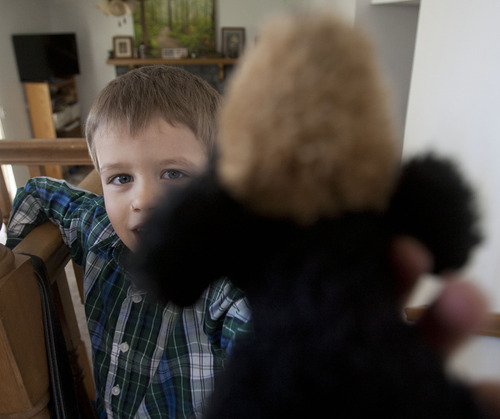This is an archived article that was published on sltrib.com in 2013, and information in the article may be outdated. It is provided only for personal research purposes and may not be reprinted.
As a married Mormon mother of three, including week-old baby Charles, Megan Richardson reflects a typical Utah woman and reasons behind a new census report that says the state again has the nation's lowest rate of births to unwed women, even as the rate here and nationwide still trends upward.
"I wasn't married until I was 30," the West Valley City resident says. "I spent a long time in my 20s wishing for children," and was even jealous of unwed mothers who gave birth. "I would actually think about having a baby on purpose."
But she was raised Mormon, so she resisted the temptation on moral grounds.
There were practical reasons, too. She saw how many single mothers struggled. And perhaps even more importantly, her parents divorced when she was 2 — and she saw little of her dad after age 8.
"That was really hard. I missed him all the time. ... I know that if it's at all possible, it's really important for children to have good, loving parents," she said. "That's partly why it took me so long to get married. I didn't ever want to get divorced" — and as a mother now she can't imagine handling her kids on her own.
But census estimates released Wednesday show 35.7 percent of U.S. babies in 2011 were born to unwed women, continuing an upward trend that started in the 1940s. Utah had the lowest-in-the-nation rate of just 14.7 percent.
"Situation normal," said University of Utah research economist Pam Perlich. "The biggest driver here is Mormon culture, for sure."
—
Generations • "We do know there is a generational change in how people are viewing families and living arrangements and marriage. That's happening in Utah, too, but the big difference here is the Mormon culture region and the high value placed on marriage and family — family being strictly defined [here] as between a man and a woman with kids.
"We know that people live in a wide, wide diversity of households besides that. But in the Mormon culture region, those other more diverse households are a smaller portion of the population."
But cultural views are changing in Utah and the nation. Perlich noted that recent Pew Research Center surveys on the "millennial" generation show "having children actually ranked higher than being married" among them, for example.
Rose Kreider, coauthor of the new census report, said that having children outside marriage became more commonplace beginning in the 1940s, but the rate of increase has grown steeper in recent years.
For example, the rate in 2007 was 80 percent higher than in 1980 nationally, and increased 20 percent between 2002 and 2007.
The report noted that recent social science studies indicate that "births outside of marriage are often associated with disadvantage for both children and their parents. Women and men who have children outside of marriage are younger on average, have less education, and have lower income than married parents."
It added, "Children who are born to unmarried parents are more likely to live in poverty and to have poor developmental outcomes."
The census report also said, "The poorer developmental and behavioral outcomes experienced by children living in cohabiting households may be due in part to family instability."
—
Rates • The study noted that nationally among women ages 15 to 19, 86.1 percent of children were born to unwed mothers. For mothers ages 20 to 24, the rate is 61.5 percent. It drops to 31.9 percent for those ages 25 to 29, and 10.3 percent for those ages 30 to 34.
Among women who have just a high school degree, 49 percent of children are born to unmarried women. But for those who have a bachelor's degree or higher, just 8.8 percent of children are born to unmarried mothers.
The lower her household income, the more likely a mother will not be married. Census estimates show that 68.9 percent of babies born in households with incomes below $10,000 a year have unwed mothers.
But in households with incomes over $200,000, the rate is just 9 percent.
Among different races nationally, the rates of births to women who are unmarried is 11.3 percent for Asians, 26 percent for whites, 40.5 for Pacific islanders, 43 percent for Hispanics, 64 percent for American Indians and 67.8 percent for blacks.
The Census Bureau says estimates show that Utah's five metropolitan areas are essentially in a statistical tie — because of sampling margins of error in surveys — with a handful of other areas for lowest rates in the nation for births to unwed women.
The estimated rates were: Provo-Orem, 8.2 percent; St. George, 10.4 percent; Logan, 10.7; Ogden-Clearfield, 14.0; and Salt Lake City, 17.9. —
Rates of births to unmarried women, 2011
1 • District of Columbia, 50.8%
2 • Louisiana, 48.7%
3 • New Mexico, 47.6%
U.S. Average: 35.7 %
49 • Montana, 23.8%
50 • New Hampshire, 19.6%
51 • Utah, 14.7%
Source: U.S. Census Bureau's American Community Survey, 2011.











